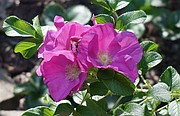Time to select and plant roses: Tips, pest recipes
Today I repeat my annual plea on behalf of the roses. Essentially hardy perennials, they want to live — and can do so for literally hundreds of years — if their purchasers/planters provide the basics: Site, proper selection, planting, and care.
Choose a sunny site with shelter from wind and snow-load. Even shade-tolerant species need five or six hours of sun each day.
Choose roses hardy to our climate: Zone 3, 4, or 5-(only in a very sunny, protected spot). Don’t be tempted by delicate Hybrid Tea roses — most are not reliable here, other than a very few, such as “Mr. Lincoln.”
Look instead for the beautiful selections among the Grandifloras, Floribundas, Polyanthas, Shrubs, and Rugosas — listed from the most tender to the hardiest — the dependable groundcover or “blanket” roses, “minis”, and hardy climbers such as William Baffin, Jacob’s Coat, New Dawn, Sally Holmes, etc. Unless you have a conservatory situation or live in a super-protected site (like Hope), stay away from the tree roses. Finally, try to buy "own-root" roses. Good names to look for are Kordes, Carefree, Morden, Buck, Weeks, Bailey, Northwest/Canadian/Minnesota, and other hardy-bred cultivars. Check the zone number and remember that Zone 5 is a big “if” in our area.
Dig a big hole — twice the width and depth of the root or pot. Since the soil in the bottom of the hole is not as fertile as that at the top, mix it all together with some peat moss or your own good compost (about 1/3 of the total amount).
Before replacing it in the hole, fill the hole halfway with water and watch it drain. It should do so in only a few minutes. Too fast means poor water retention and too slow means dense soil that can cause root rot and other problems. Aged manure in the bottom of the hole is good, with a mound of soil over it before planting so the roots are not in direct contact.
Planting:
Plant your rose according to individual directions or about 1 inch deeper than it is in the pot or above the graft bulge (if using a grafted rose). Fill in with your soil, give the plant a good drink, let drain, then replace the remaining soil, tamp lightly, and let the rose rest and take hold.
Watering: Roses need plenty of water, at least one and preferably two inches of water a week throughout the growing season. Soaker hoses are best, since droplets on the leaves/petals can not only discolor them but cause blackspot. Give a thorough soaking two or three times a week or as necessary depending on the weather, and preferably early in the day.
Fertilizer: A multitude of rose fertilizers advertise their efficiency, but I pretty much stick with fish emulsion. Use it — or whichever you choose — as directed, right now, then again in mid-July, and finally in late August or early September. Then no more at all, so the roses can prepare for dormancy and don’t need the pep and growing vigor that fertilizer provides.
NO-NOs:
- Never plant a rose in the same soil where another rose has grown. The soil must be completely replaced in the entire area before replanting. Some nurseries will not guarantee their stock if planted in old holes.
- If you’ve bought a “box” rose, it is likely a hybrid tea and not dependable here. To help save it, do NOT prune it back after planting as the box describes. This is for people who live in California or Arizona and not in our cold-soil area.
- Let a rose grow for at least two to three years before spring (never fall) pruning. (This does not mean you cannot cut away dead, diseased, or crossing limbs, or “shape” the bush at most anytime after blooming, but save the heavy pruning for early pre-bud springtime).
Recipes for aphids, etc.: Aphids can become almost epidemic at times, and the usual simple spray of water or Neem (insecticidal soap) just doesn’t do the trick. Here are some homemade recipes from rose experts for aphids and scale.
Aphids: (1) 1/4 cup household bleach in 3 gallons of water; spray on plants when aphids show up. (2) 1 tablespoon mild soap (Ivory or Castile) plus 1 teaspoon horticultural oil in 1 gallon of water.
Scale: This oyster-shell-shaped insect sucks the sap and life from roses, appearing as a crusty, fuzzy or bubbly growth on stems and leaves and eventually turning yellow and fall off. You can scrape small areas off with your fingernail of a file, or try this: 1 pint of insecticidal soap (Safer’s) plus 1 tablespoon of isopropyl alcohol. You may also prune off encrusted canes.
Finally, where roses are concerned, cleanliness is paramount. Keep leaves and litter from underneath the plants (except when mulching in winter), and use organic means of fertilization. Just love ‘em and leave ‘em, and they’ll reward you for a lifetime.
(Editor’s note: For many years, Valle Novak wrote gardening and cooking columns for the Daily Bee. “Weekend Gardener” and “Country Chef” became renowned for their humor, information, and common sense advice on how to do everything from planting to cooking. While she recently passed away, she has left behind a number of columns to share with and delight her many fans. This is one such column and was originally published on April 18, 2010.)





